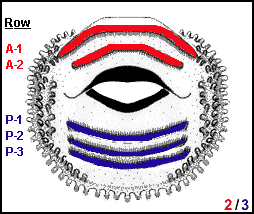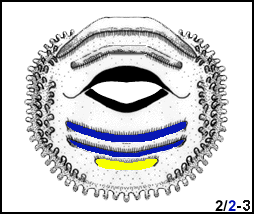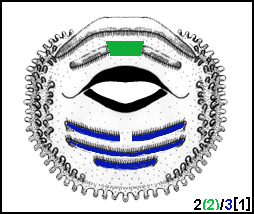
 |
The LTRF is written as a fraction designating the location and number of labial tooth rows. The most common LTRF is 2/3. The numerator indicates the number of rows on A, the anterior labium, while the denominator indicates the number of rows on P, the posterior labium. A LTRF only tells how many tooth rows there are on each labium and which ones have medial gaps-the lengths or positions of the rows are not designated. In the drawing on the left, the anterior labium has 2 rows, A-1 and A-2; the posterior labium has 3 rows, P-1, P-2 and P-3. Rows are numbered from anterior to posterior on each labium. |
| Ontogenetic or geographic variation in the number of tooth rows is indicated with a hyphen. Tooth rows are added during development in the following sequence: A-1, P-2, A-2, P-1, P-3, and, if more rows are present, continue in an approximately alternate upper/lower sequence on each labium. A hyphen can be used to indicate ontogenetic variation or variation among species within a genus, as shown in the LTRF 2/2-3 in the drawing on the right. |  |
 |
A number in parentheses designates a labial tooth row with a median gap. In the drawing to the left, the median gap is shown in the second row of the anterior labium. |
| As illustrated in the drawing to the right, a number in brackets indicates variation in the presence of a median gap. The first row in the posterior labium may or may not have a median gap...2(2)/3[1]. |  |
The proportional relationship of the length of one tooth row to another (e.g., length of P-2 divided by length of P-3) or of half of a tooth row to its gap (e.g., length of left half of A-2 divided by length of A-2 gap) is useful sometimes to distinguish among species.